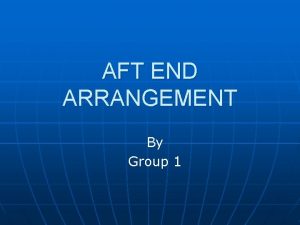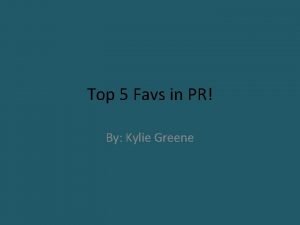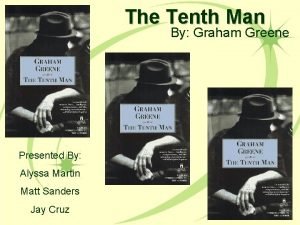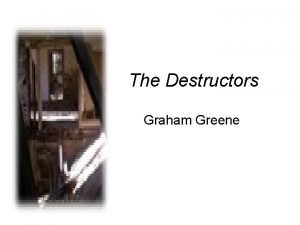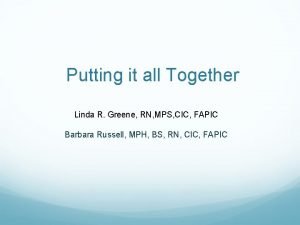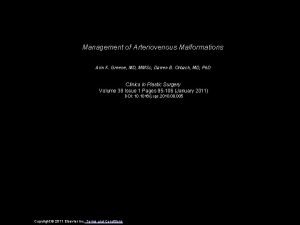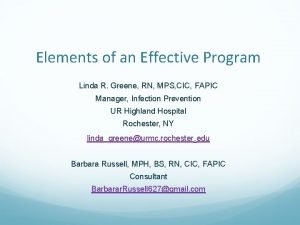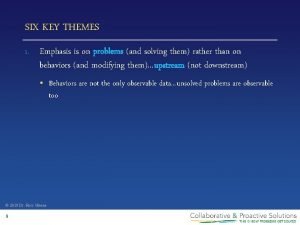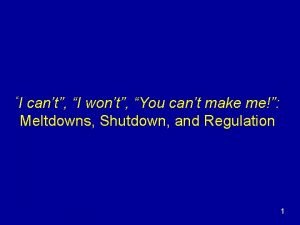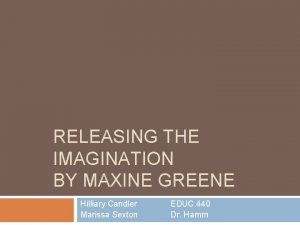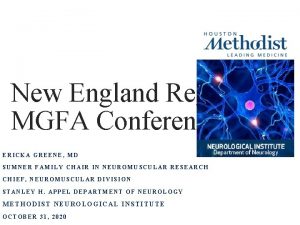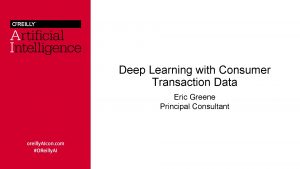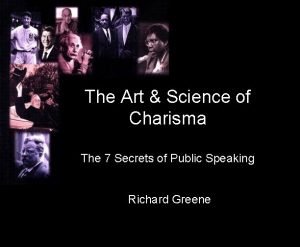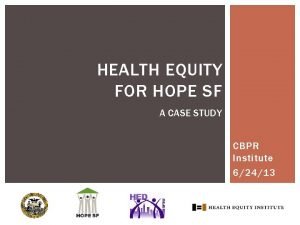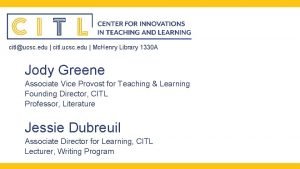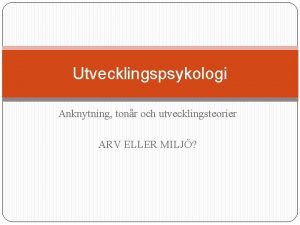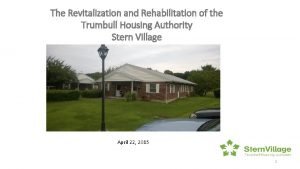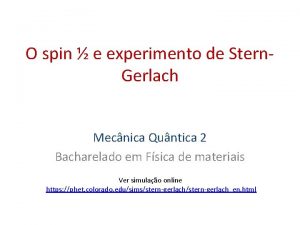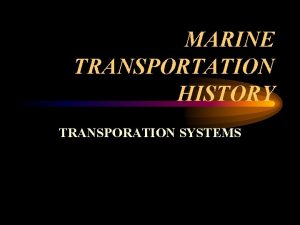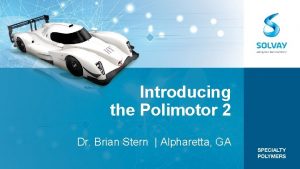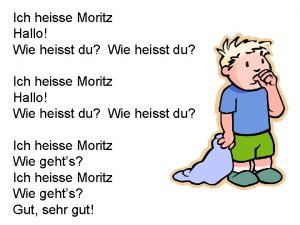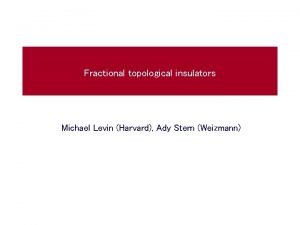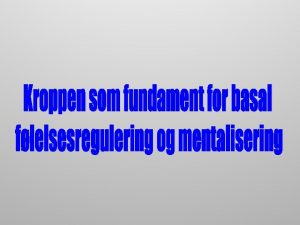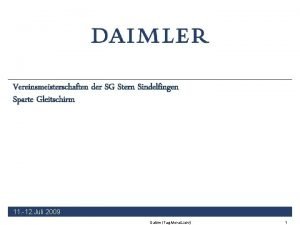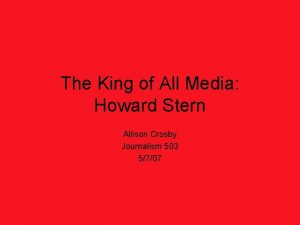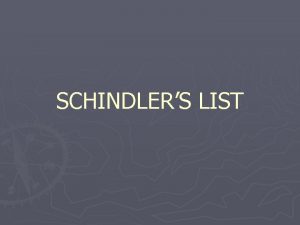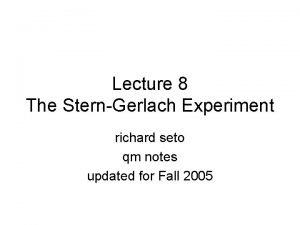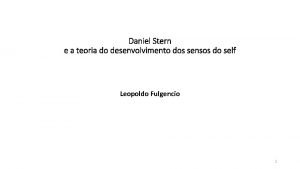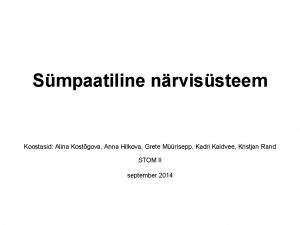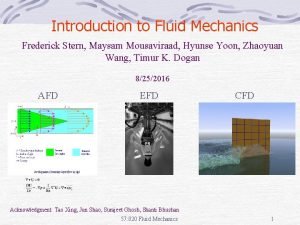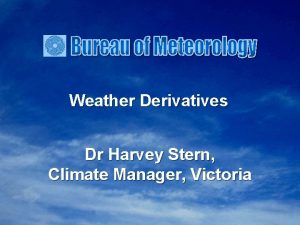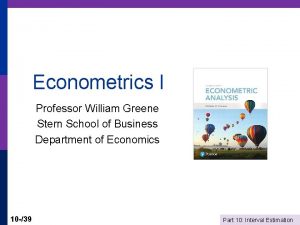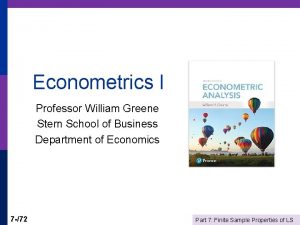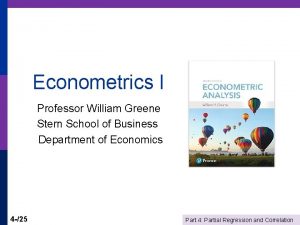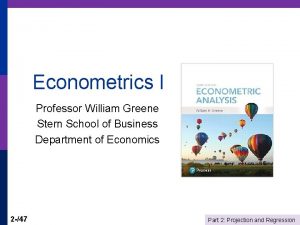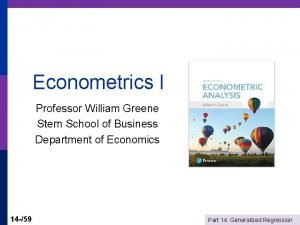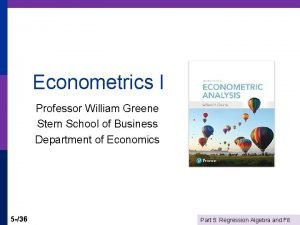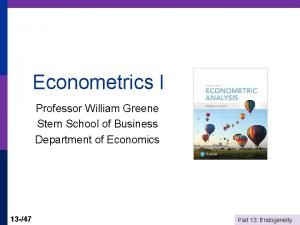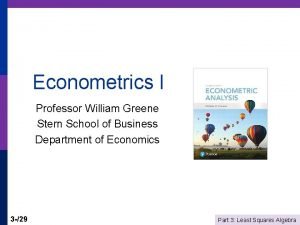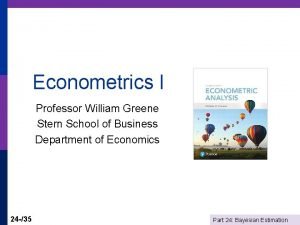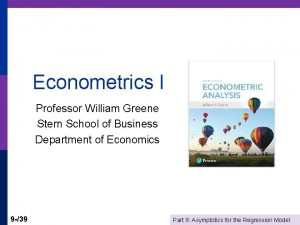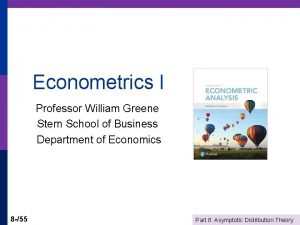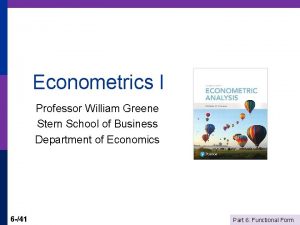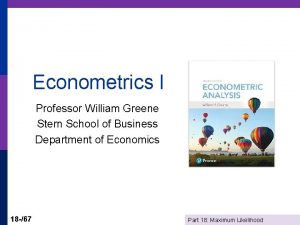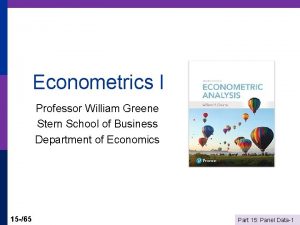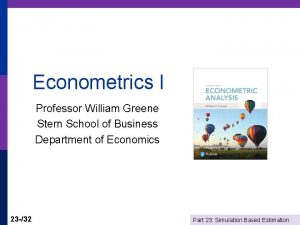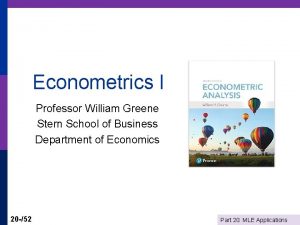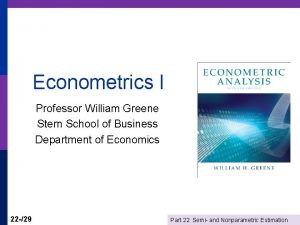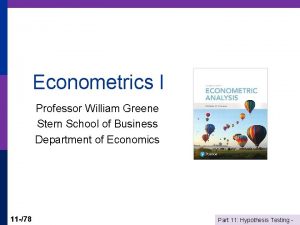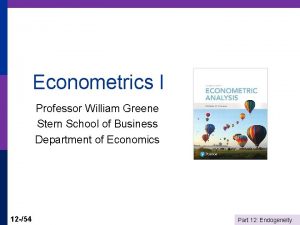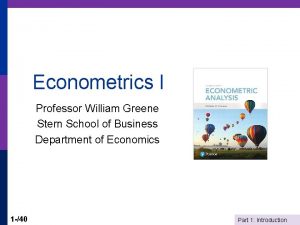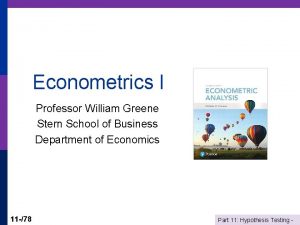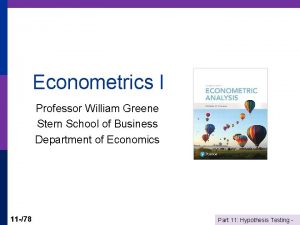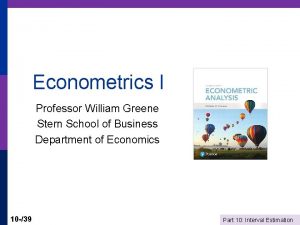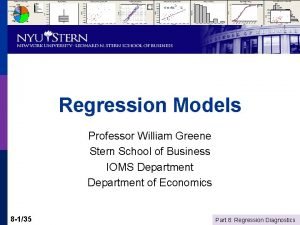Econometrics I Professor William Greene Stern School of










![Selection as a Specification Error E[yi|xi, yi observed] = β’xi + θλi p Regression Selection as a Specification Error E[yi|xi, yi observed] = β’xi + θλi p Regression](https://slidetodoc.com/presentation_image/10e83f1527daa0b9e884b417b1095a4b/image-11.jpg)





























- Slides: 40

Econometrics I Professor William Greene Stern School of Business Department of Economics 19 -/39 Part 19: Sample Selection

Econometrics I Part 19 – Sample Selection Two Step Estimation 19 -/39 Part 19: Sample Selection

19 -3/39 Part 19: Sample Selection

Dueling Selection Biases – From two emails, same day. “I am trying to find methods which can deal with data that is non-randomised and suffers from selection bias. ” selection bias p “I explain the probability of answering questions using, among other independent variables, a variable which measures knowledge breadth. Knowledge breadth can be constructed only for those individuals that fill in a skill description in the company intranet. This is where the selection bias comes from. p 19 -4/39 Part 19: Sample Selection

Samples and Populations p Consistent estimation n n The sample is randomly drawn from the population Sample statistics converge to their population counterparts A presumption: The ‘population’ is the population of interest. p Implication: If the sample is randomly drawn from a specific subpopulation, statistics converge to the characteristics of that subpopulation p 19 -5/39 Part 19: Sample Selection

Nonrandom Sampling p p Simple nonrandom samples: Average incomes of airport travelers mean income in the population as a whole? Survivorship: Time series of returns on business performance. Mutual fund performance. (Past performance is no guarantee of future success. ) Attrition: Drug trials. Effect of erythropoetin on quality of life survey. Self-selection: n n 19 -6/39 Labor supply models Shere Hite’s (1976) “The Hite Report” ‘survey’ of sexual habits of Americans. “While her books are ground-breaking and important, they are based on flawed statistical methods and one must view their results with skepticism. ” Part 19: Sample Selection

The Crucial Element p Selection on the unobservables n n n p Selection into the sample is based on both observables and unobservables. All the observables are accounted for. Unobservables in the selection rule also appear in the model of interest (or are correlated with unobservables in the model of interest). “Selection Bias” = the bias due to not accounting for the unobservables that link the equations. 19 -7/39 Part 19: Sample Selection

Heckman’s Canonical Model 19 -8/39 Part 19: Sample Selection

Standard Sample Selection Model 19 -9/39 Part 19: Sample Selection

Incidental Truncation u 1, u 2~N[(0, 0), (1, . 71, 1) 19 -10/39 Part 19: Sample Selection
![Selection as a Specification Error Eyixi yi observed βxi θλi p Regression Selection as a Specification Error E[yi|xi, yi observed] = β’xi + θλi p Regression](https://slidetodoc.com/presentation_image/10e83f1527daa0b9e884b417b1095a4b/image-11.jpg)
Selection as a Specification Error E[yi|xi, yi observed] = β’xi + θλi p Regression of yi on xi omits λi. p n n n λi will generally be correlated with xi if zi is. zi and xi often have variables in common. There is no specification error if θ = 0 <=> ρ = 0 “Selection Bias” is plim (b – β) p What is “selection bias…” p 19 -11/39 Part 19: Sample Selection

Control Function 19 -12/39 Part 19: Sample Selection

Estimation of the Selection Model p Two step least squares n n n p Inefficient Simple – exists in current software Simple to understand widely used Full information maximum likelihood n n n 19 -13/39 Efficient Simple – exists in current software Not so simple to understand – widely misunderstood Part 19: Sample Selection

Estimation Heckman’s two step procedure (1) Estimate the probit model and compute λi for each observation using the estimated parameters. n (2) a. Linearly regress yi on xi and λi using the observed data b. Correct the estimated asymptotic covariance matrix for the use of the estimated λi. (An application of Murphy and Topel (1984) – Heckman was 1979) See text, pp. 953 -955. n 19 -14/39 Part 19: Sample Selection

Variance of a Heckman’s Two Step Estimator 19 -15/39 Part 19: Sample Selection

Application – Labor Supply MROZ labor supply data. Cross section, 753 observations Use LFP for binary choice, KIDS for count models. LFP = labor force participation, 0 if no, 1 if yes. WHRS = wife's hours worked. 0 if LFP=0 KL 6 = number of kids less than 6 K 618 = kids 6 to 18 WA = wife's age WE = wife's education WW = wife's wage, 0 if LFP=0. RPWG = Wife's reported wage at the time of the interview HHRS = husband's hours HA = husband's age HE = husband's education HW = husband's wage FAMINC = family income MTR = marginal tax rate WMED = wife's mother's education WFED = wife's father's education UN = unemployment rate in county of residence CIT = dummy for urban residence AX = actual years of wife's previous labor market experience AGE = Age AGESQ = Age squared EARNINGS= WW * WHRS LOGE = Log of EARNINGS KIDS = 1 if kids < 18 in the home. 19 -16/39 Part 19: Sample Selection

Labor Supply Model NAMELIST ; Z = One, KL 6, K 618, WA, WE, HA, HE $ NAMELIST ; X = One, KL 6, K 618, Agesq, WE, Faminc $ PROBIT ; Lhs = LFP ; Rhs = Z ; Hold(IMR=Lambda) $ SELECT ; Lhs = WHRS ; Rhs = X $ REGRESS ; If [ LFP = 1] ; Lhs = WHRS ; Rhs = X, Lambda ; Cluster = 1 $ 19 -17/39 Part 19: Sample Selection

Participation Equation 19 -18/39 Part 19: Sample Selection

Hours Equation 19 -19/39 Part 19: Sample Selection

Selection “Bias” 19 -20/39 Part 19: Sample Selection

Heckman’s corrected standard errors Uncorrected standard errors - OLS Heteroscedasticity robust standard errors (cluster = 1) 19 -21/39 Part 19: Sample Selection

Maximum Likelihood Estimation 19 -22/39 Part 19: Sample Selection

MLE Two Step Estimates 19 -23/39 Part 19: Sample Selection

How to Handle Selectivity p The ‘Mills Ratio’ approach – just add a ‘lambda’ to whatever model is being estimated? n n p The Heckman model applies to a probit model with a linear regression. The conditional mean in a nonlinear model is not something “+lambda” The model can sometimes be built up from first principles 19 -24/39 Part 19: Sample Selection

Received Sunday, April 27, 2014 I have a paper regarding strategic alliances between firms, and their impact on firm risk. While observing how a firm’s strategic alliance formation impacts its risk, I need to correct for two types of selection biases. The reviews at Journal of Marketing asked us to correct for the propensity of firms to enter into alliances, and also the propensity to select a specific partner, before we examine how the partnership itself impacts risk. Our approach involved conducting a probit of alliance formation propensity, take the inverse mills and include it in the second selection equation which is also a probit of partner selection. Then, we include inverse mills from the second selection into the main model. The review team states that this is not correct, and we need an MLE estimation in order to correctly model the set of three equations. The Associate Editor’s point is given below. Can you please provide any guidance on whether this is a valid criticism of our approach. Is there a procedure in LIMDEP that can handle this set of three equations with two selection probit models? AE’s comment: “Please note that the procedure of using an inverse mills ratio is only consistent when the main equation where the ratio is being used is linear. In non-linear cases (like the second probit used by the authors), this is not correct. Please see any standard econometric treatment like Greene or Wooldridge. A MLE estimator is needed which will be far from trivial to specify and estimate given error correlations between all three equations. ” 19 -25/39 Part 19: Sample Selection

A Bivariate Probit Model 19 -26/39 Part 19: Sample Selection

FT/PT Selection Model +-----------------------+ | FIML Estimates of Bivariate Probit Model | | Dependent variable FULLFP | | Weighting variable None | | Number of observations 753 | | Log likelihood function -723. 9798 | | Number of parameters 16 | | Selection model based on LFP | +-----------------------+ +--------------+--------+---------+-----+ |Variable | Coefficient | Standard Error |b/St. Er. |P[|Z|>z] | Mean of X| +--------------+--------+---------+-----+ Index equation for FULLTIME Constant. 94532822 1. 61674948. 585. 5587 WW -. 02764944. 01941006 -1. 424. 1543 4. 17768154 KL 6. 04098432. 26250878. 156. 8759. 14018692 K 618 -. 13640024. 05930081 -2. 300. 0214 1. 35046729 AGE. 03543435. 07530788. 471. 6380 41. 9719626 AGESQ -. 00043848. 00088406 -. 496. 6199 1821. 12150 WE -. 08622974. 02808185 -3. 071. 0021 12. 6588785 FAMINC. 210971 D-04. 503746 D-05 4. 188. 0000 24130. 4229 Index equation for LFP Constant. 98337341. 50679582 1. 940. 0523 KL 6 -. 88485756. 11251971 -7. 864. 0000. 23771580 K 618 -. 04101187. 04020437 -1. 020. 3077 1. 35325365 WA -. 02462108. 01308154 -1. 882. 0598 42. 5378486 WE. 16636047. 02738447 6. 075. 0000 12. 2868526 HA -. 01652335. 01287662 -1. 283. 1994 45. 1208499 HE -. 06276470. 01912877 -3. 281. 0010 12. 4913679 Disturbance correlation RHO(1, 2) -. 84102682. 25122229 -3. 348. 0008 Full Time = Hours > 1000 19 -27/39 Part 19: Sample Selection

Building a Likelihood for a Poisson Regression Model with Selection 19 -28/39 Part 19: Sample Selection

Building the Likelihood 19 -29/39 Part 19: Sample Selection

Dear Professor Greene, I am very sorry to bother you considering this is my first time emailing you. I am ********, lecturer in Finance at &&&&&& University (Scotland). I am doing a project investigating the impact of hedge fund manager's coinvestment on the survival probability of the fund. As fund managers' coinvestment decision is self-selection which might cause endogeneity issue, I jointly estimate the co-investment decision (Probit model) and the survival probability (Hazard model) to account for endogeneity of co-investment decision. I received one comment saying that I should use Heckman's two procedure to correct for endogeneity. My understanding is the Heckman's approach applies to a Probit and a LINEAR model. Since hazard model is nonlinear, simply adding inverse Mill's ration in the hazard model is wrong. What I am asking is if my understanding of this is correct? If so, why can we not simply add Mill's ratio in a nonlinear model? 19 -30/39 Part 19: Sample Selection

Conditional Likelihood 19 -31/39 Part 19: Sample Selection

Poisson Model with Selection p Strategy: n n p Hermite quadrature or maximum simulated likelihood. Not by throwing a ‘lambda’ into the unconditional likelihood Could this be done without joint normality? n n n 19 -32/39 How robust is the model? Is there any other approach available? Not easily. The subject of ongoing research Part 19: Sample Selection

Nonnormality Issue How robust is the Heckman model to nonnormality of the unobserved effects? p Are there other techniques p n n Parametric: Copula methods Semiparametric: Klein/Spady and Series methods Other forms of the selection equation – e. g. , multinomial logit p Other forms of the primary model: e. g. , as above. p 19 -33/39 Part 19: Sample Selection

Application: Health Care Usage German Health Care Usage Data, 7, 293 Individuals, Varying Numbers of Periods This is an unbalanced panel with 7, 293 individuals. There altogether 27, 326 observations. The number of observations ranges from 1 to 7. (Frequencies are: 1=1525, 2=2158, 3=825, 4=926, 5=1051, 6=1000, 7=987). (Downloaded from the JAE Archive) Variables in the file are DOCTOR = 1(Number of doctor visits > 0) HOSPITAL = 1(Number of hospital visits > 0) HSAT = health satisfaction, coded 0 (low) - 10 (high) DOCVIS = number of doctor visits in last three months HOSPVIS = number of hospital visits in last calendar year PUBLIC = insured in public health insurance = 1; otherwise = 0 ADDON = insured by add-on insurance = 1; otherswise = 0 HHNINC = household nominal monthly net income in German marks / 10000. (4 observations with income=0 were dropped) HHKIDS = children under age 16 in the household = 1; otherwise = 0 EDUC = years of schooling AGE = age in years MARRIED = marital status 19 -34/39 Part 19: Sample Selection

19 -35/39 Part 19: Sample Selection

19 -36/39 Part 19: Sample Selection

19 -37/39 Part 19: Sample Selection

19 -38/39 Part 19: Sample Selection

19 -39/39 Part 19: Sample Selection

19 -40/39 Part 19: Sample Selection
 Transom stern and cruiser stern
Transom stern and cruiser stern Promotion from assistant to associate professor
Promotion from assistant to associate professor Kylie greene
Kylie greene The tenth man graham greene summary
The tenth man graham greene summary Stokes theorem
Stokes theorem Graham greene destructors
Graham greene destructors Linda r greene
Linda r greene Journey without maps graham greene
Journey without maps graham greene Robert greene shakespeare
Robert greene shakespeare Arin greene
Arin greene Linda r greene
Linda r greene Alsup ross greene
Alsup ross greene Collaborative problem solving plan a b c
Collaborative problem solving plan a b c Maxine greene releasing the imagination
Maxine greene releasing the imagination Ericka simpson md
Ericka simpson md Eric greene course
Eric greene course 7 secrets of the sensitive
7 secrets of the sensitive Uzuri pease-greene
Uzuri pease-greene Robin dunkin ucsc
Robin dunkin ucsc Stern utvecklingspsykologi
Stern utvecklingspsykologi Stern village trumbull ct
Stern village trumbull ct Sea transport solutions stern landing vessel
Sea transport solutions stern landing vessel Dr theodore stern
Dr theodore stern On a ship, its corresponds to a floor in a building *
On a ship, its corresponds to a floor in a building * Experimento de stern-gerlach
Experimento de stern-gerlach Bow stern port starboard
Bow stern port starboard Dr brian stern
Dr brian stern Ich heisst du
Ich heisst du Ady stern
Ady stern Daniel stern model
Daniel stern model Sg stern sindelfingen
Sg stern sindelfingen King of all media
King of all media إسحاق ستيرن
إسحاق ستيرن Ben kingsley som itzak stern
Ben kingsley som itzak stern Stern-gerlach experiment lecture notes
Stern-gerlach experiment lecture notes Stern teoria
Stern teoria Noolemürk ehk
Noolemürk ehk Photomontage meaning
Photomontage meaning Frederick stern
Frederick stern Stern rudder ap world history
Stern rudder ap world history Dr harvey stern
Dr harvey stern
